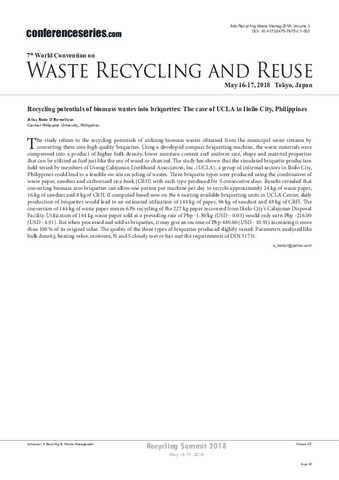Показать сокращенную информацию
Recycling potentials of biomass wastes into briquettes: The case of UCLA in Iloilo City, Philippines
| dc.contributor.author | Romallosa, Aries Roda D. | |
| dc.coverage.spatial | Iloilo | en_US |
| dc.date.accessioned | 2022-07-14T01:07:36Z | |
| dc.date.available | 2022-07-14T01:07:36Z | |
| dc.date.issued | 2018 | |
| dc.identifier.citation | Romallosa, A. R. D. (2018). Recycling potentials of biomass wastes into briquettes: The case of UCLA in Iloilo City, Philippines [Paper presentation]. 7th World Convention on Waste Recycling and Reuse, Tokyo, Japan. | en_US |
| dc.identifier.issn | 2475-7675 | |
| dc.identifier.uri | https://hdl.handle.net/20.500.12852/2164 | |
| dc.description | Conference paper | en_US |
| dc.description.abstract | The study relates to the recycling potentials of utilizing biomass wastes obtained from the municipal waste streams by converting them into high quality briquettes. Using a developed compact briquetting machine, the waste materials were compressed into a product of higher bulk density, lower moisture content and uniform size, shape and material properties that can be utilized as fuel just like the use of wood or charcoal. The study has shown that the simulated briquette production field-tested by members of Uswag Calajunan Livelihood Association, Inc. (UCLA), a group of informal sectors in Iloilo City, Philippines could lead to a feasible on-site recycling of wastes. Three briquette types were produced using the combination of waste paper, sawdust and carbonized rice husk (CRH) with each type produced for 5 consecutive days. Results revealed that converting biomass into briquettes can allow one person per machine per day to recycle approximately 24 kg of waste paper, 16 kg of sawdust and 8 kg of CRH. If computed based now on the 6 existing available briquetting units in UCLA Center, daily production of briquettes would lead to an estimated utilization of 144 kg of paper, 96 kg of sawdust and 48 kg of CRH. The conversion of 144 kg of waste paper means 63% recycling of the 227 kg paper recovered from Iloilo City's Calajunan Disposal Facility. Utilization of 144 kg waste paper sold at a prevailing rate of Php -1.50/kg (USD - 0.03) would only earn Php -216.00 (USD - 4.91). But when processed and sold as briquettes, it may give an income of Php-480.00 (USD - 10.91) increasing it more than 100 % of its original value. The quality of the three types of briquettes produced slightly varied. Parameters analyzed like bulk density, heating value, moisture, N and S closely met or has met the requirements of DIN 51731. | en_US |
| dc.language.iso | en | en_US |
| dc.publisher | Hilaris | en_US |
| dc.relation.uri | https://www.hilarispublisher.com/conference-abstracts-files/2475-7675-C1-003-004.pdf | en_US |
| dc.subject.lcsh | Biomass | en_US |
| dc.subject.lcsh | Biomass energy | en_US |
| dc.subject.lcsh | Briquets (Fuel) | en_US |
| dc.subject.lcsh | Briquets | en_US |
| dc.subject.lcsh | Recycling (Waste, etc.) | en_US |
| dc.subject.lcsh | Biomass--Recycling | en_US |
| dc.subject.lcsh | Philippines--Iloilo | en_US |
| dc.title | Recycling potentials of biomass wastes into briquettes: The case of UCLA in Iloilo City, Philippines | en_US |
| dc.title.alternative | Recycling potentials of biomass wastes into briquettes: The case of Uswag Calajunan Livelihood Association, Inc. (UCLA) in Iloilo City, Philippines | en_US |
| dc.type | Conference paper | en_US |
| dcterms.accessRights | Publicly accessible | en_US |
| dc.citation.firstpage | 38 | en_US |
| local.subject | Uswag Calajunan Livelihood Association, Inc. (UCLA) | en_US |
| dc.citation.conferencetitle | 7th World Convention on Waste Recycling and Reuse | en_US |


